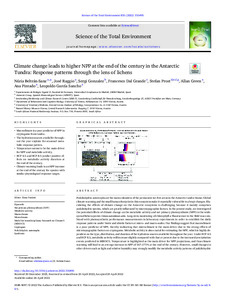Por favor, use este identificador para citar o enlazar este ítem:
http://hdl.handle.net/20.500.11765/13743
Climate change leads to higher NPP at the end of the century in the Antarctic Tundra: Response patterns through the lens of lichens
Registro completo de metadatos
| Campo DC | Valor | Lengua/Idioma |
|---|---|---|
| dc.contributor.author | Beltrán Sanz, Núria | es_ES |
| dc.contributor.author | Raggio, José | es_ES |
| dc.contributor.author | González Herrero, Sergi | es_ES |
| dc.contributor.author | Dal Grande, Francesco | es_ES |
| dc.contributor.author | Prost, Stefan | es_ES |
| dc.contributor.author | Green, Allan | es_ES |
| dc.contributor.author | Pintado Valverde, Ana | es_ES |
| dc.contributor.author | García Sancho, Leopoldo | es_ES |
| dc.date.accessioned | 2022-06-03T09:48:52Z | - |
| dc.date.available | 2022-06-03T09:48:52Z | - |
| dc.date.issued | 2022 | - |
| dc.identifier.citation | Science of the Total Environment. 2022, 835, 155495 | es_ES |
| dc.identifier.issn | 0048-9697 | - |
| dc.identifier.issn | 1879-1026 | - |
| dc.identifier.uri | http://hdl.handle.net/20.500.11765/13743 | - |
| dc.description.abstract | Poikilohydric autotrophs are the main colonizers of the permanent ice-free areas in the Antarctic tundra biome. Global climate warming and the small human footprint in this ecosystem make it especially vulnerable to abrupt changes. Elucidating the effects of climate change on the Antarctic ecosystem is challenging because it mainly comprises poikilohydric species, which are greatly influenced by microtopographic factors. In the present study, we investigated the potential effects of climate change on the metabolic activity and net primary photosynthesis (NPP) in the widespread lichen species Usnea aurantiaco-atra. Long-term monitoring of chlorophyll a fluorescence in the field was combined with photosynthetic performance measurements in laboratory experiments in order to establish the daily response patterns under biotic and abiotic factors at micro- and macro-scales. Our findings suggest that macroclimate is a poor predictor of NPP, thereby indicating that microclimate is the main driver due to the strong effects of microtopographic factors on cryptogams. | es_ES |
| dc.description.sponsorship | This study was financed by grant CIM2015-64728-C2-1-R and PID2019-105469RB-C21 from the Spanish Ministry of Economy and Competitiveness. | es_ES |
| dc.language.iso | eng | es_ES |
| dc.publisher | Elsevier | es_ES |
| dc.rights | Licencia CC: Reconocimiento–NoComercial–SinObraDerivada CC BY-NC-ND | es_ES |
| dc.subject | Net primary photosynthesis | es_ES |
| dc.subject | Macroclimate | es_ES |
| dc.subject | Microclimate | es_ES |
| dc.subject | Cryptogam | es_ES |
| dc.subject | Metabolic activity | es_ES |
| dc.subject | Symbiosis | es_ES |
| dc.title | Climate change leads to higher NPP at the end of the century in the Antarctic Tundra: Response patterns through the lens of lichens | es_ES |
| dc.type | info:eu-repo/semantics/article | es_ES |
| dc.relation.publisherversion | https://doi.org/10.1016/j.scitotenv.2022.155495 | es_ES |
| dc.rights.accessRights | info:eu-repo/semantics/openAccess | es_ES |
| Colecciones: | Artículos científicos 2019-2022 | |
Ficheros en este ítem:
| Fichero | Descripción | Tamaño | Formato | ||
|---|---|---|---|---|---|
| STE_2022_beltran.pdf | 956,06 kB | Adobe PDF |  Visualizar/Abrir | ||
| Supp_material.docx | 570,56 kB | Microsoft Word XML | Visualizar/Abrir |
Los ítems de Arcimis están protegidos por una Licencia Creative Commons, salvo que se indique lo contrario.





